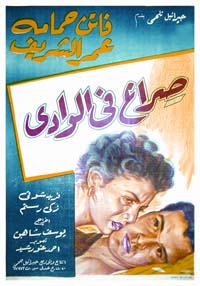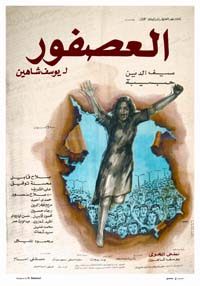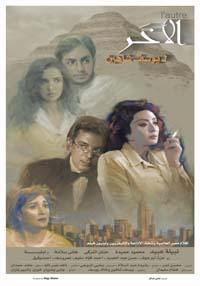INTRODUCTION TO EGYPTIAN CINEMA
BY SAMIR FARID *
 The earliest projections using a “Lumière” cinematograph in Egypt took place on the 15 November 1896, at the Toussoun Exchange in Alexandria, then in Cairo on 28th November, that is, less than one year after the first projection in Paris, on 28 December 1895. Egypt’s first “Lumière cinematograph” cinema opened its doors in Alexandria in 1897. By 1926 – that is, by the end of the silent cinema era – 86 cinemas were operating in Egypt. The family of Mohamed Ali had reigned in Eygpt since 1805. Their reign ended with the “revolution” of the military in 1952 and the declaration of the Republic in 1953.
The earliest projections using a “Lumière” cinematograph in Egypt took place on the 15 November 1896, at the Toussoun Exchange in Alexandria, then in Cairo on 28th November, that is, less than one year after the first projection in Paris, on 28 December 1895. Egypt’s first “Lumière cinematograph” cinema opened its doors in Alexandria in 1897. By 1926 – that is, by the end of the silent cinema era – 86 cinemas were operating in Egypt. The family of Mohamed Ali had reigned in Eygpt since 1805. Their reign ended with the “revolution” of the military in 1952 and the declaration of the Republic in 1953.

City of Cairo
With the advent of the “talkies”, the number of cinemas increased. By 1958, there were 395 of them. However, their number began to decline when television was introduced in 1960, followed by the public-sector cinema industry. In 1965, only 297 cinemas remained open, and by 1995, there were just 141. This decline was not only due to competition from television and the distribution of films on video cassette. Nor was it entirely thanks to other modern technical media. There were other contributing factors including, above all, the deterioration of services available in public-sector cinemas (cinemas had been either nationalised or expropriated) and the lack of any new cinemas being opened (for fear of being subjected to the same fate). A final cause of the decline was the act that was passed in 1973, which gave the Ministry of Culture the power to intervene in cinema programming.
Thanks to various laws and measures implemented to encourage investment in the creation of cinemas, their number has increased again, especially in shopping centres. There were 200 cinemas in 2001 and 400 in 2009, for a population of 77 million (or 80 million if you include expatriate Eygptians).
 |
 |
 |
| Struggle in the Valley by Y Chahine, 1954 | The Sparrow by Y Chahine, 1972 | The Other by Y Chahine, 1999 |
In 2009, 120 films – mainly Hollywood productions – were screened in Egypt. 39 were Egyptian films and a few were from Europe and India. The box-office revenue reached 55 million dollars. Egyptian films accounted for 80% of the market share.
The film market in Egypt is one of only three markets in the world where domestically produced films hold the greatest market share, thanks to laws and measures protecting national production. The major American film companies in Hollywood, which hold the greatest share of the international market both within and outside the United States, are opposed to these laws and measures, which they consider to be protectionist measures that contravene treaties on the free circulation of goods between nations, and that violate laws and measures relating to free trade.
In 1897, the Lumière company sent the cameraman Promio to Egypt, where he filmed 36 short films, of which 18 have been found. These French films were the first films made in Egypt. The first Egyptian film, a short film entitled “The Visit of the Khedive Abbas Helmi to the Scientific Institute of the Sidi Aboul Abbas Mosque ”, dates from 1907. It was produced by the company Aziz and Doris (Aziz Bandarli and Emberto Malafassi, known as Dorès) and screened on the 20th of June, 1907. This is why, during the celebration in 2007 of the centenary of cinema, the Library of Alexandria made the 20th of June “Egyptian Cinema Day”.
 |
 |
| Lighthouse of Alexandria | Library of Alexandria (reconstruction) |
In 2009, the number of Egyptian short films reached 3,000. They include fiction films, documentaries, animation films and student productions belonging to one or other of the three preceding generations. Mohamed Bayoumi (1894-1963) was one of the pioneers of the Egyptian documentary, although he also made fiction films and is considered as the first Egyptian film maker to work in cinema. We should also mention Saad Nadim (1920-1980), Salah El Touhami (1922-1997) and Abdel Kader Telemsani (1924-2003), and notable pioneers of animation films include the Frankel brothers, Antoine Sélim, who died in 1998, and Ahmed El Matini (1934-1996).
It was in 1927 that silent feature-length fiction films began to be made in Egypt and in 1932, talkies appeared. According to a filmography by the author of the present overview, 3,124 films were screened between 1932 and 2009. Given the volume of the production (4,000 films made, including the silent films and the ones that were not screened), and the influence of Egyptian cinema on national and Arabic-speaking audiences, Egypt is in 10th position worldwide and in first place on the African continent, in the Arab world and the Middle East. Between 1933 and 1963 – a period in which more than 1,000 fiction films were produced, sharing a number of common specific traits, particularities, and characteristic features – a fully-fledged “Egyptian school of film” existed.
 A number of reasons explain why in Egypt, more than in any other Arab, African or Muslim country (or at least with a Muslim majority), the cinema industry experienced such development during the first half of the 20th century. The most important reason relates to the development of the dramatic arts: in the majority, film audiences are the same as those who used to go to the theatre. Myriam Sammate was the first Egyptian to go on stage in 1907 and in 1915, Mounira El Mahdiyya was the first Muslim stage actress. The Fine Arts Faculty was created in 1908 and the Egyptians accepted seeing their lives represented in the theatre, and then on screen. There is no drama without men and women, or without human flaws that create discord between them. If Egyptian audiences could accept seeing corrupt officials in high places, adulterous spouses, etc., it is because they found the strength and the courage to be confronted with the negative aspects of their society, in particular during the rise of nationalism under the reign of the Khediv Abbas Helmi II, at the very beginning of the 20th century. Under the slogan: “Egypt for the Egyptians!” a whole series of events unfurled: the great popular revolution of 1919, the Egyptian conquest of political independence in 1922 and finally the Constitution of 1923, the first of the modern constitutions to be adopted by Arab and Muslim states.
A number of reasons explain why in Egypt, more than in any other Arab, African or Muslim country (or at least with a Muslim majority), the cinema industry experienced such development during the first half of the 20th century. The most important reason relates to the development of the dramatic arts: in the majority, film audiences are the same as those who used to go to the theatre. Myriam Sammate was the first Egyptian to go on stage in 1907 and in 1915, Mounira El Mahdiyya was the first Muslim stage actress. The Fine Arts Faculty was created in 1908 and the Egyptians accepted seeing their lives represented in the theatre, and then on screen. There is no drama without men and women, or without human flaws that create discord between them. If Egyptian audiences could accept seeing corrupt officials in high places, adulterous spouses, etc., it is because they found the strength and the courage to be confronted with the negative aspects of their society, in particular during the rise of nationalism under the reign of the Khediv Abbas Helmi II, at the very beginning of the 20th century. Under the slogan: “Egypt for the Egyptians!” a whole series of events unfurled: the great popular revolution of 1919, the Egyptian conquest of political independence in 1922 and finally the Constitution of 1923, the first of the modern constitutions to be adopted by Arab and Muslim states.
The creation in 1913 of the “association of the friends of the theatre”, which would later become the “friends of the theatre and the cinema”, is one of the results of this vast movement. In 1923, the government created the Institute of Arab Music, and in 1930, the Institute of Dramatic Arts, which was closed in 1931, after only one brief year of instruction, under the pretext that the interaction of male and female students was of an embarrassingly promiscuous nature. In 1933, the government presented awards with monetary prizes for the best films screened in 1932. Barely five years separated this initiative from the first international film competition (the American Oscars in 1927) and it came just one year after the first international film festival in Venice, in 1932.
In 1943, the Institute of Dramatic Arts once again became a department of the Higher Institute of Dramatic Arts. The creation of the actors’ union and the union of film professionals dates from the same year. Two years later, in 1945, the musicians’ union was created. In 2009, these unions counted 50,000 professional members. A Chamber of Commerce for the film industry was created in 1947, as a branch of the Egyptian Federation of Industries. In 2009, 300 companies were registered. The year 1958 saw the creation of the first Institute of Cinematographic arts.

Until its nationalisation in 1961, the Misr Studio produced 57 films between 1936 and 1956, and 125 films between 1936 and 1960, according to the writer of this article. Among its most important productions, the weekly publication between 1939 and 1960 of “Cinematographic Egypt” must be mentioned. Its photographer was Hassan Mourad (1903-1970). After nationalisation, the weekly was taken over by the television company and then by the National Bureau of Information. Other great studios followed the creation of the Misr Studio: Nassibane in 1937, Jalal in 1944, Al Ahram in 1945 and Nahhas in 1948. With the exception of the first of these which was closed, these studios were still in existence in 2009, side by side with those of the Media Production City, belonging to the television company. As for industrial film laboratories, only two remain today: the Misr laboratory and the one belonging to the Film Institute. The Ministry of Culture developed this latter one. It is now called “Cinema City” and it is directed by the “Media Production City”.
 |
 |
 |
| Alexandria-New York directed by Y Chahine, 2004 | Destiny directed by Y Chahine, 1997 | Cutting from a scene, Destiny |
|
Here are some more key dates: • 1911: adoption of the first law on cinema in Egypt;
|
READ >>> EGYPTIAN FILMS AT THE FESTIVAL DE CANNES
* Samir Farid is a journalist and film historian.
The Festival de Cannes would like to thank the authors for contributing for free.

